It’s hard to truly grasp the extent of Birmingham city center’s evolution unless you experienced it before the late 1990s, before the significant redevelopment efforts began. Returning to Birmingham now, after living here prior to its transformation, often feels disorienting. Familiar landmarks have been replaced by modern structures, showcasing a city reborn. Among these changes, the transformation of Birmingham’s main railway hub, the New Street Railway Station, stands out as a remarkable example of urban renewal.
Indeed, beneath the expansive ETFE skylights of the new street railway station, today’s travelers experience a level of comfort and modernity unseen since 1967. The station has undergone a dramatic overhaul, changing not just its appearance but also its functionality and its role within the city.
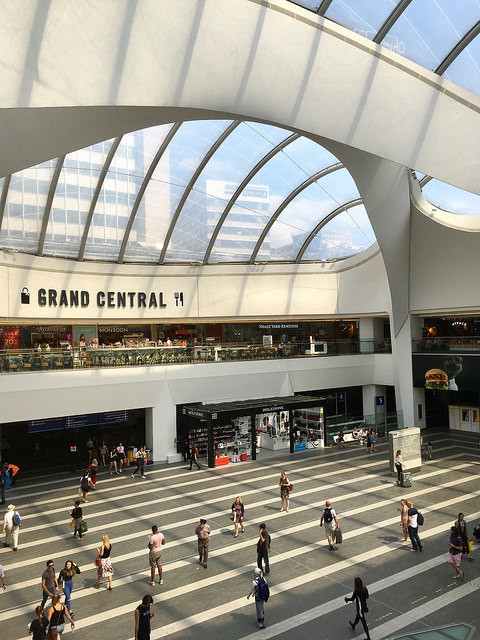 Atrium view of the redeveloped New Street station, showcasing natural light from ETFE skylights and spacious concourse.
Atrium view of the redeveloped New Street station, showcasing natural light from ETFE skylights and spacious concourse.
A History of Birmingham New Street Station
Reconstructed during British Railways’ modernization initiative of the 1950s and 60s on the West Coast Main Line connecting London and Glasgow, the new street railway station I remember from my university days was a massive, cumbersome structure disrupting city movement. It constantly seemed to obstruct routes to the west of New Street itself—the very street for which the station is named. This 1960s station was actually a replacement for an even earlier New Street station. Originally, there were two adjacent stations; the older London and North Western station featured an elegant glass and iron trainshed roof, which unfortunately suffered irreparable damage during World War II.
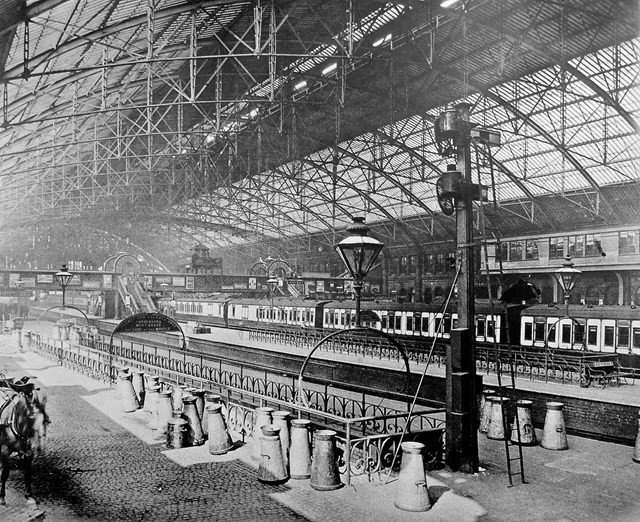 Historical image of the original New Street station interior, highlighting the glass and iron trainshed roof.
Historical image of the original New Street station interior, highlighting the glass and iron trainshed roof.
The new street railway station built in the 1960s presented a stark contrast. It was concealed beneath a shopping complex known as the Pallasades. Positioned in a cutting, the station’s platforms were below ground level. British Rail capitalized on the air rights above, allowing for the construction of the shopping center. However, while situated above the platforms, the shopping center barely rose above ground level on the New Street side, and even less so on the opposite side due to the sloping terrain. The result was a dismal combination of station and shopping center.
The Challenges of the Old New Street Station
While I appreciate some of the 1960s architectural efforts along the West Coast Main Line, such as the rebuilt Euston (despite its subsequent issues) and the impressive Coventry station (though poorly maintained), New Street station was never appealing. Even the Brutalist signal box at New Street station, while architecturally significant, couldn’t redeem the station’s passenger experience.
The platforms of the old new street railway station were notoriously gloomy, with ceilings too low to effectively vent diesel fumes, creating a claustrophobic environment. Only at the very ends of the platforms was there any hint of daylight, offering views of towering concrete walls.
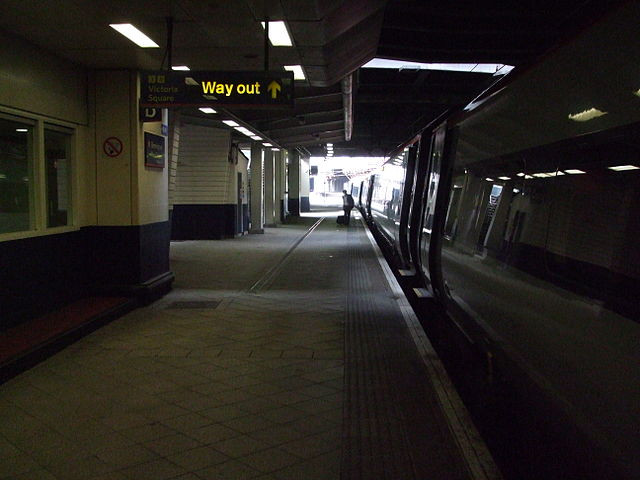 Platform view of the old New Street station in 2009, showing dimly lit and cramped conditions with low ceilings.
Platform view of the old New Street station in 2009, showing dimly lit and cramped conditions with low ceilings.
Above the platforms, the concourse and ticket hall were cramped, confusing, and chaotic. Navigating to the platforms was challenging for first-time visitors, and the experience upon arrival was often disappointing. The station felt squeezed beneath the Pallasades shopping center, with transportation clearly secondary to retail interests. Furthermore, the Pallasades itself was an unappealing shopping environment, especially by the time I frequented it regularly. A narrow, inconvenient bridge connected to the Bull Ring shopping center, which was arguably even worse than the Pallasades.
 Concourse of the pre-2015 New Street station, illustrating the cramped and outdated passenger environment.
Concourse of the pre-2015 New Street station, illustrating the cramped and outdated passenger environment.
By the close of the 20th century, it was evident that significant changes were needed. The subsequent revitalization of Birmingham city center is a larger narrative, but central to this transformation was the rebuilding of Birmingham new street railway station and the shopping center above it.
The Ambitious Redevelopment Project
Visiting Birmingham today, the transformation is striking. Areas once dominated by 1960s concrete are now occupied by gleaming glass and steel retail spaces. Amidst this urban metamorphosis, the redeveloped Birmingham new street railway station stands as a focal point. While not without its imperfections, it represents a substantial improvement.
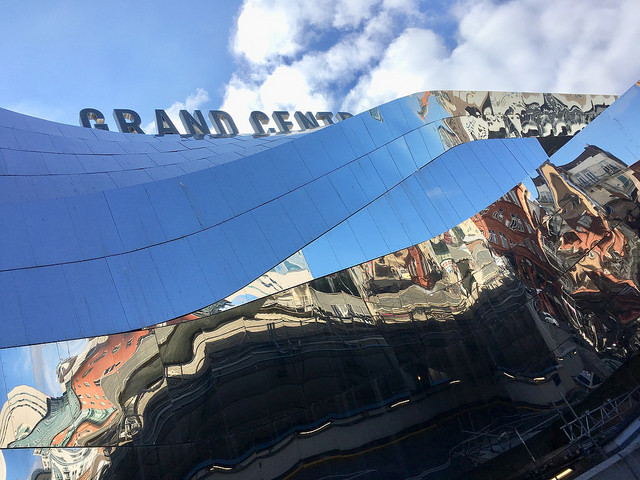 Reflective exterior facade of the modern New Street station, blending with and standing out from the urban landscape.
Reflective exterior facade of the modern New Street station, blending with and standing out from the urban landscape.
Plans for a £350 million redevelopment were announced in 2005. By its completion in 2015, the project’s cost had escalated to £750 million. Birmingham City Council envisioned the new street railway station as a more fitting gateway to the city, while the rail industry aimed to enhance capacity and passenger experience amidst growing numbers.
Full planning permission was secured in 2010, initiating a five-year reconstruction program. Foreign Office Architects won the design competition after initial concepts were deemed either too radical or not bold enough. While Foreign Office Architects gained recognition for projects like the Yokohama International Port Terminal, the new street railway station became their final collaborative venture. The project transitioned to AZPML, the new firm of Alejandro Zaera-Polo, following the partners’ separation.
The redevelopment encompassed a complete overhaul of the station concourse and the Pallasades. The project, initially known as Birmingham Gateway, ultimately saw the upper-level shopping center rebranded as Grand Central. This ambitious naming choice invites comparison to New York’s iconic Grand Central Terminal. But how does Birmingham’s new street railway station measure up, and what did this significant investment achieve? Undoubtedly, it’s a vast improvement over the 1967 station, both aesthetically and functionally. And surprisingly, it shares more similarities with its New York namesake than one might expect.
Design and Features of the New Station
Approaching the new street railway station, its bold design statement is immediately apparent, harmonizing with Birmingham’s revitalized urban landscape. The station is encased in an undulating, mirror-finish façade of polished stainless steel. This façade is purely decorative, with AZPML acknowledging its detachment from the building’s structure. Yet, it’s visually striking, reflecting its surroundings in a way that simultaneously blends in and stands out. It has transformed the new street railway station and its Grand Central shopping center into a true city landmark, unlike the Pallasades and the previous station entrance.
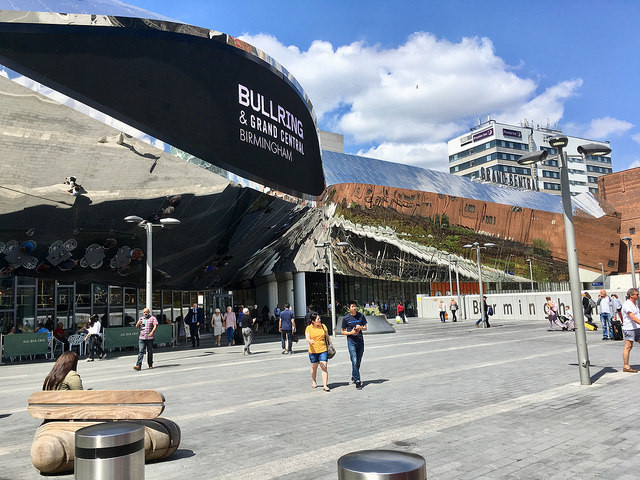 Entrance to the redeveloped New Street station, highlighting the modern design and improved accessibility.
Entrance to the redeveloped New Street station, highlighting the modern design and improved accessibility.
The redesign has significantly improved pedestrian flow around the new street railway station at street level. Walking around the station is now much easier, often along sheltered routes beneath the projecting reflective façade, which acts as an effective wayfinding element. This enhanced permeability for pedestrians and cyclists is a key, often overlooked, benefit of the new street railway station redevelopment, perhaps even more impactful than its more flamboyant design features.
The main entrances to Grand Central feature prominent “media eyes”—large, ellipsoid LED display screens. While Network Rail promoted these as state-of-the-art advertising spaces, their unusual shape is reminiscent of the Martian war machines from the 1953 film adaptation of The War of the Worlds. Some may find them somewhat unsettling, particularly when displaying images of eyes.
Inside, the transformation from the old new street railway station is most dramatic. The shops and concourse are now integrated at the same level, eliminating the previously separated arrangement with retail above the station. An additional gallery level of shops encircles a spacious central atrium. Crucially, massive ETFE skylight windows now flood the concourse with natural light for the first time in decades.
 ETFE skylights in the New Street station atrium, providing natural light to the concourse level.
ETFE skylights in the New Street station atrium, providing natural light to the concourse level.
The wide passageways leading into the atrium from the station entrances feature wave-shaped ceiling slats, adding textural interest. AZPML describes these elements as representing the geometries of motion. Integrated lighting between the slats provides illumination without disrupting the design aesthetic.
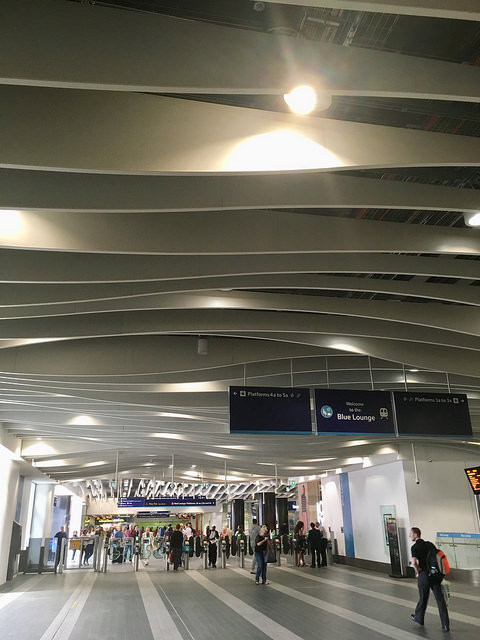 Ceiling detail in New Street station, showcasing wave-shaped slats and integrated lighting.
Ceiling detail in New Street station, showcasing wave-shaped slats and integrated lighting.
The atrium itself, with its ETFE windows, is a design highlight. The curving, branching roof structure evokes the work of Santiago Calatrava, but AZPML’s inspiration draws from railway trackwork, specifically pointwork and diverging tracks. The atrium is undeniably photogenic, a stark contrast to the 1967 station. Passenger waiting areas are thoughtfully situated in two gated sections, serving platforms 1-5 and 6-12 respectively, with a central space allowing shoppers to pass through.
The atrium’s roof structure presented the most complex design challenge. A compromise was reached to clad the roof struts with PVC fabric, a decision reportedly disliked by Zaera-Polo, who envisioned plasterboard or sculpted steel.
Escalators within the atrium lead to the gallery level, Grand Central shopping center, and a new connection to the rebuilt Bullring shopping center.
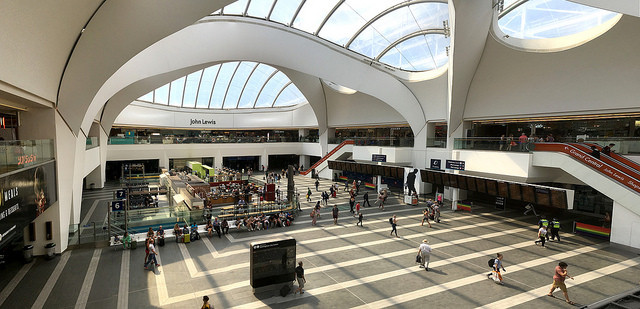 Atrium view from the gallery level, showing escalators, shops, and the expansive space of New Street station.
Atrium view from the gallery level, showing escalators, shops, and the expansive space of New Street station.
The New Station: Successes and Shortcomings
A common critique of the new street railway station is that its design prioritizes shopping over its function as a transportation hub. It’s undeniable that the station is designed as a “destination station,” aligning with Network Rail’s vision of stations as community hubs, even for those not traveling by train. However, this approach also serves to generate revenue for Network Rail. Ultimately, if this model provides a more engaging and comfortable waiting environment, it can be seen as a positive evolution for railway stations adapting to modern needs. This trend is not unique to Birmingham, with examples like the Oculus at the World Trade Center Transportation Hub and even Grand Central Terminal in New York embracing a similar mixed-use approach.
The arrival and waiting experience at the new street railway station has been revolutionized. However, the improvements are less pronounced when descending to the platforms. While daylight now reaches the concourse, it doesn’t penetrate to the platform level. The platforms remain under the shadow of the shopping center above, still feeling somewhat cramped when crowded. Refurbishments have aimed to brighten the platform areas, and while there is a slight improvement, it is limited.
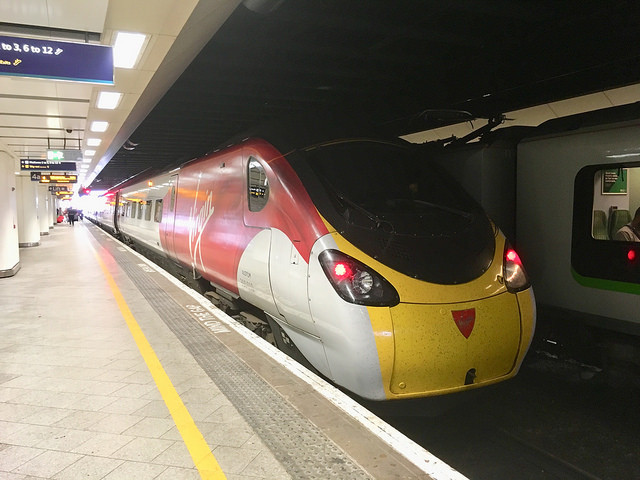 Refurbished platforms at New Street station, showing brighter finishes but still retaining a dark and enclosed atmosphere.
Refurbished platforms at New Street station, showing brighter finishes but still retaining a dark and enclosed atmosphere.
Significant platform improvements would necessitate a more radical approach, potentially involving demolishing the shopping center above to allow natural light to reach the platforms, reminiscent of the pre-1960s station. Plans for additional platforms in tunnels beneath the existing ones have also been considered. Such extensive renovations, however, face financial and logistical hurdles in the near future.
Despite these platform limitations, the new street railway station represents a significant upgrade overall. Passenger satisfaction surveys indicate a substantial improvement in user perception since the redevelopment. Within the first six months of reopening, passenger satisfaction rose from 66% to 81%.
Interestingly, New York’s Grand Central Terminal, despite also having impressive concourse areas but less appealing platforms, frequently ranks among the world’s best stations. Perhaps Birmingham’s new street railway station can find some solace in this comparison, even if platform users might remain less enthusiastic.
How to find New Street station
Click here for The Beauty of Transport‘s map
Bibliography and Further Reading
AZPML’s project page for the New Street station rebuild, here
Network Rail’s history of New Street station, here
Article about the architecture of the new New Street station from The Guardian, here
…and anything else linked to in the text above
Share this:
Like Loading…

